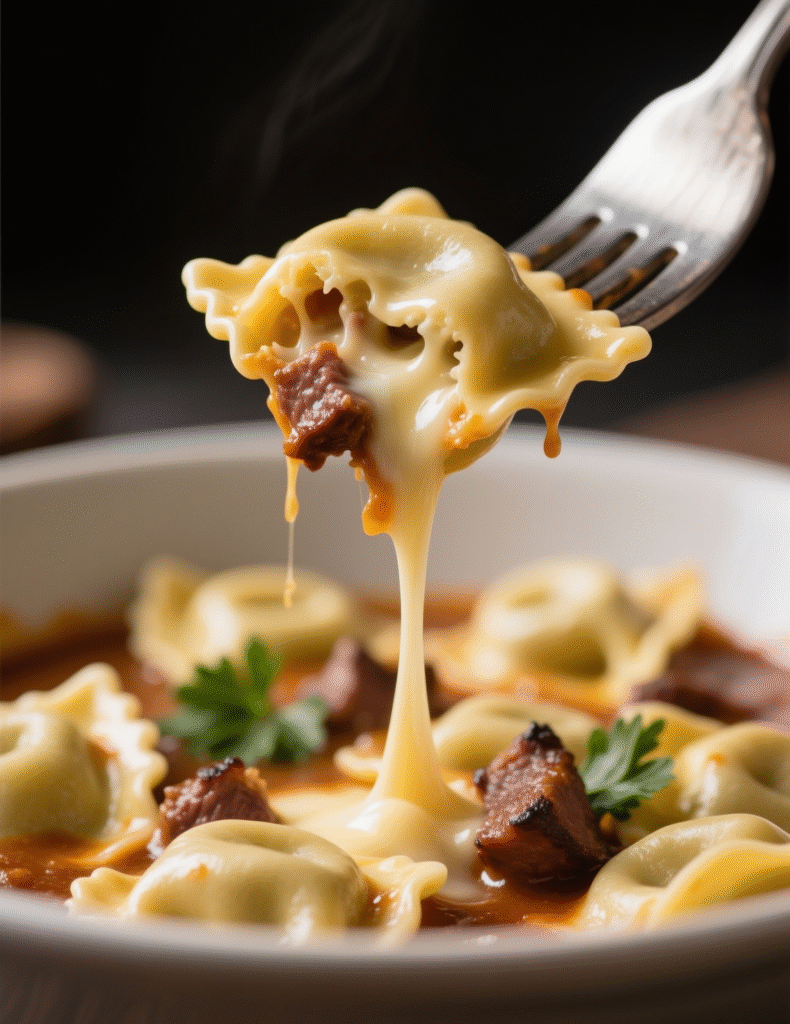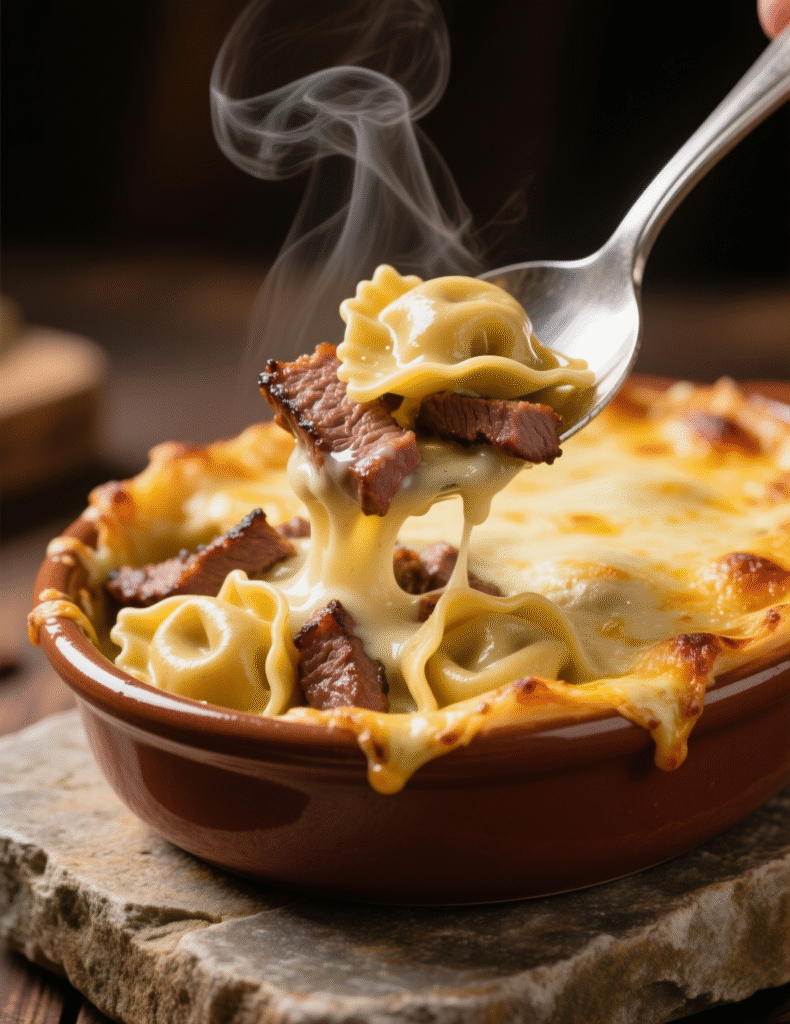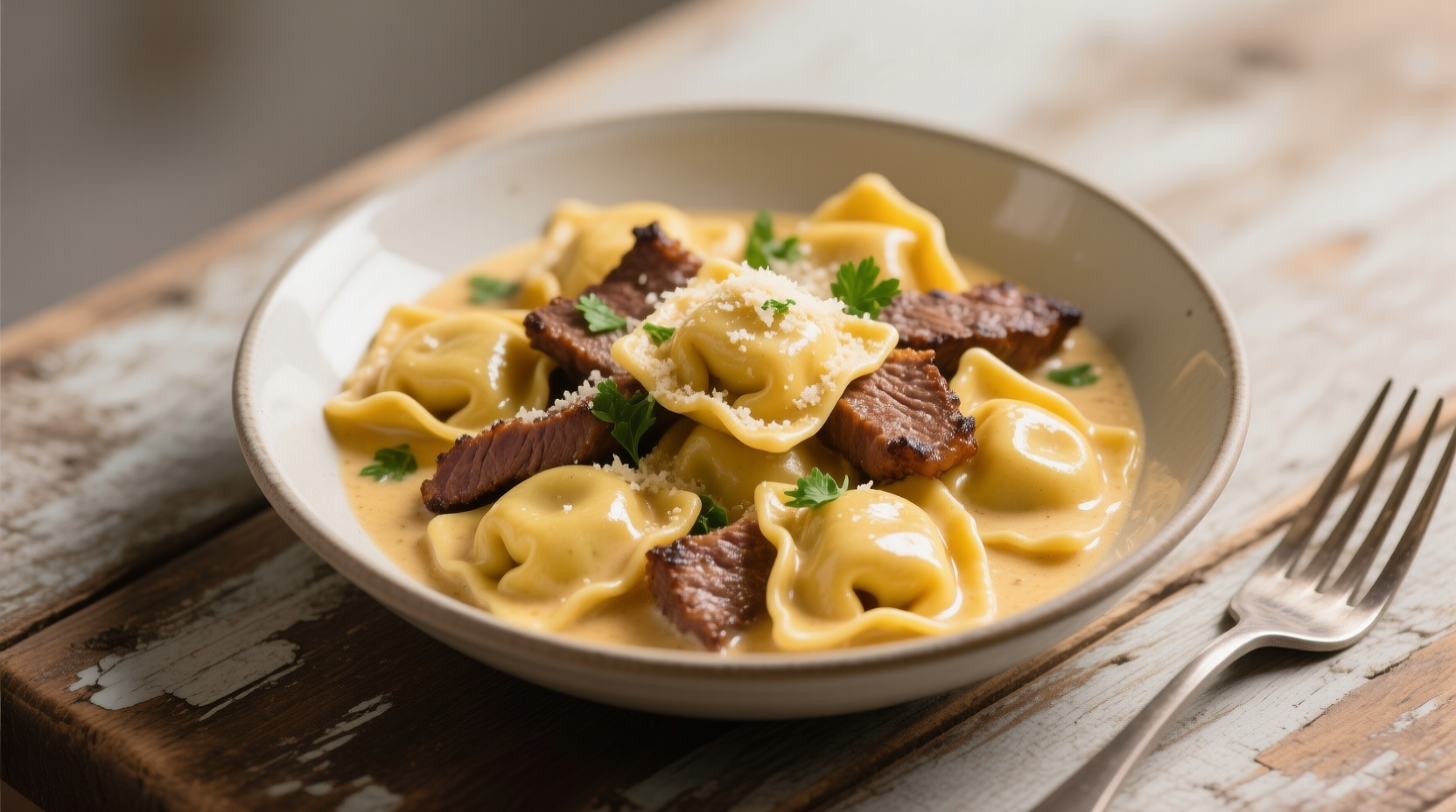Cheesesteak and pasta rarely meet at the same table, but when they do, magic happens. Cheesesteak Tortellini in Rich Provolone Sauce isn’t just a playful recipe—it’s a culinary hybrid that borrows bold flavors from Philadelphia’s iconic sandwich and folds them gently into the elegance of fresh tortellini and creamy cheese sauce. The purpose here isn’t only to create something indulgent, but also to explore how two very different food traditions can work hand in hand when balance and technique are respected.
Why Cheesesteak Tortellini Works
Fusion food often gets accused of being gimmicky, but this dish proves otherwise. At its heart, a cheesesteak is about beef, onions, peppers, melted cheese, and bread. Replace the bread with tortellini, let provolone take over as the sauce base, and suddenly the concept feels less like a trick and more like an elevated pasta dish with steakhouse character.
Professional chefs will recognize the key here is restraint. Too much pepper and onion, the sauce gets muddy. Too heavy with provolone, the dish turns cloying. You want the tortellini to carry some of the richness while the sauce and steak act as both anchor and highlight.
Choosing the Beef: Ribeye or Bust
If you ask a Philadelphian about cheesesteak meat, ribeye wins every time. It’s marbled enough to stay juicy even when sliced thin and seared hard. For this dish, you’ll want to partially freeze the ribeye before slicing. A firm ribeye allows for paper-thin strips, which cook quickly and avoid the chewiness that ruins the eating experience.
Lean cuts, like sirloin, can technically work but often leave you fighting with dry edges. And no, ground beef is not an acceptable shortcut here. Professionals know texture is as important as taste, and ground beef simply doesn’t replicate the steak bite.
Building the Provolone Sauce
Here’s where many home cooks trip. A provolone sauce isn’t just melted provolone tossed with cream—that gives you stringy, greasy cheese sludge. The goal is an emulsified sauce with depth, silky mouthfeel, and stability on the plate.
Start with a simple roux—equal parts butter and flour, cooked gently until blond. Slowly whisk in whole milk or a light cream base. Then add shredded sharp provolone, a cheese with just enough bite to remind you it’s not mozzarella. Avoid pre-shredded cheese; anti-caking agents interfere with smooth melting.
Some chefs fold in a touch of fontina or low-moisture mozzarella to stabilize the sauce. Others finish with a splash of chicken stock to thin it down. Both tricks work. The end texture should nap the back of a spoon without clumping or separating.

Tortellini: Fresh or Packaged?
Here’s the big debate. Do you make your own tortellini, or do you grab a quality package from the store?
For professionals, fresh tortellini is the standard. It lets you control filling, texture, and size. A classic ricotta-spinach filling or even plain cheese works beautifully as the filling doesn’t compete too hard with the beef. If making fresh pasta isn’t in the cards, store-bought cheese tortellini is acceptable but choose one with delicate dough. Thick or chewy pasta shells will feel heavy when paired with the steak and sauce.
Interestingly, fresh tortellini cooks faster and absorbs sauce more readily. Packaged versions often need more boiling time, which slightly alters texture once plated.
Flavor Building: Vegetables Matter
The steak is the star, but the peppers and onions set the stage. Skip them, and the dish feels flat. Go overboard, and it becomes a stir-fry instead of pasta.
Onions should be sautéed until golden, not burnt, and peppers need a quick blister to release sweetness while keeping a slight crunch. Some chefs prefer red peppers for their balance of sweet and earthy, while green peppers lean sharper and more bitter. In professional kitchens, blending both creates dimension.
Garlic, though not always traditional in cheesesteaks, belongs in the sauce base. Just a whisper, not enough to scream “Italian pasta,” but enough to provide warmth in the background.
Cooking Technique: Heat Control Is Everything
Thin steak cooks in less than two minutes. Too much heat, you’ll scorch it. Too little, it steams and turns gray. The sweet spot is a ripping-hot pan, preferably cast iron, with a light coat of neutral oil. Spread the steak in a single layer, resist the urge to move it, then flip quickly to finish.
Vegetables should cook separately. Throwing them in with steak waters down the meat and prevents proper caramelization. Professionals know: keep moisture under control at every stage.
Balancing the Dish: Assembly Is Key
This dish isn’t a one-pot wonder, though it looks like one when plated. You’ve got three moving parts: the tortellini, the steak-pepper mix, and the provolone sauce.
Cook tortellini until just al dente. Drain, then immediately fold it into the sauce so the pasta absorbs flavor before cooling. Arrange the steak-pepper mixture over the top, letting juices mingle without drowning the pasta. A sprinkle of fresh parsley or shaved provolone adds a final note of freshness.
This structure matters. If you combine everything in one pot, the steak risks overcooking, vegetables lose identity, and the dish becomes a muddle. Treat each element as its own performance, then bring them together for the finale.
Portioning and Plating
In restaurant service, portion control separates a composed plate from a chaotic heap. Tortellini should form the base—about a tight cup per plate. Sauce clings to the pasta, not floods it. Steak strips lay gently on top, not buried beneath.
Plating in shallow bowls rather than flat plates helps. Pasta wants a nest. A wide rimmed bowl frames the dish, prevents sauce spillage, and offers natural contrast when garnished with bright herbs.
Common Mistakes and How to Avoid Them
- Overcooked Steak – The fastest way to ruin flavor and texture. Slice thin, cook quick, remove early.
- Broken Sauce – Happens when cheese is added to liquid that’s too hot. Keep sauce just below a simmer, and whisk constantly.
- Heavy Pasta – Tortellini that’s thick or overcooked becomes gummy. Test a piece early and trust your palate over the package directions.
- Unbalanced Flavors – Too much onion or pepper overpowers delicate provolone. Think supporting cast, not rival star.
- Under-seasoning – With cheese-heavy dishes, salt is critical. Taste at every stage, don’t wait until the end.

Nutritional Perspective
This dish is indulgent, no doubt. A single serving often hits 600–800 calories depending on sauce richness. Protein is solid from both beef and cheese, but sodium levels climb quickly if not careful. Using part-skim cheese, leaner cuts of beef, and portion control makes it manageable even in professional menu planning.
For chefs aiming to adapt this to lighter menus, swap cream base for evaporated milk, and use grilled steak instead of pan-seared. The result stays flavorful but trims excess fat.
Professional Variations
- Mushroom Add-In – Sautéed cremini mushrooms deepen umami without overpowering.
- Spicy Kick – A touch of Calabrian chili paste folded into sauce adds heat for adventurous diners.
- Aged Provolone Blend – Mixing young and aged provolone gives a balance of sharp bite and creamy melt.
- Bread Garnish – Mini toasted hoagie rolls on the side bridge the cheesesteak inspiration and pasta elegance.
Pairings: Wine and Beyond
Wine pairing often gets overlooked with pasta-fusion dishes. Cheesesteak tortellini pairs beautifully with medium-bodied reds like Barbera or Montepulciano. These wines cut through fat while supporting savory notes.
Beer works too. A crisp lager balances richness, while a malty amber ale complements caramelized onions and steak. For non-alcoholic service, sparkling water with lemon keeps the palate refreshed.
Cultural and Culinary Context
Dishes like this reflect how American cuisine evolves—fusion not for novelty but for expression. The cheesesteak itself was once seen as lowbrow street food. Bringing it into pasta format elevates it without stripping away the identity. It’s comfort food that dares to be plated with finesse.
Final Thoughts
Cheesesteak Tortellini in Rich Provolone Sauce is more than a recipe; it’s proof that culinary traditions thrive when they’re allowed to collide thoughtfully. Professionals know balance is everything—between sauce and pasta, between steak and vegetables, between comfort and refinement.
Done right, this dish wins hearts at the table and respect in the kitchen. It teaches restraint, celebrates flavor layering, and shows how even something as humble as a Philly cheesesteak can be reborn in the language of fine pasta.
FAQs
What cut of beef is best for cheesesteak tortellini?
Ribeye is ideal because of its marbling and tenderness when thinly sliced.
Can I use store-bought tortellini for this recipe?
Yes, but fresh tortellini offers better texture and flavor absorption.
How do I prevent the provolone sauce from breaking?
Keep heat low, add cheese gradually, and whisk constantly.
Should the vegetables be cooked with the steak?
No, cook them separately to avoid excess moisture and loss of flavor.
Can I make this dish lighter or healthier?
Yes, use lean steak, part-skim cheese, and evaporated milk instead of cream.
What wine pairs well with cheesesteak tortellini?
Medium-bodied reds like Barbera or Montepulciano work beautifully.
Is provolone the only cheese option?
You can blend provolone with mozzarella or fontina for smoother sauce.
How do I keep the steak tender?
Slice it paper-thin and cook quickly over very high heat.
What’s the biggest mistake to avoid with this dish?
Overcooking the steak or tortellini, which ruins texture and balance.
Can I prepare this dish ahead of time?
You can prep components, but assemble just before serving for best results.

Mariana is a passionate home cook who creates delicious, easy-to-follow recipes for busy people. From energizing breakfasts to satisfying dinners and indulgent desserts, her dishes are designed to fuel both your body and hustle.
When she’s not in the kitchen, she’s exploring new flavors and dreaming up her next recipe to share with the Foodie Hustle community.

